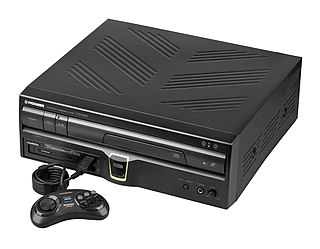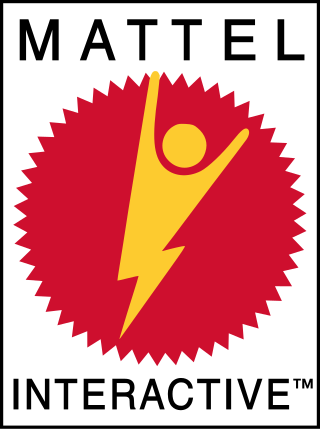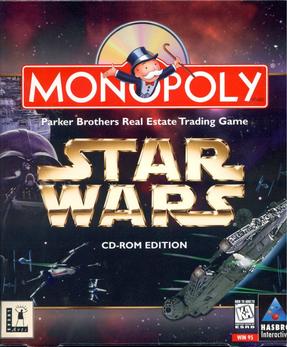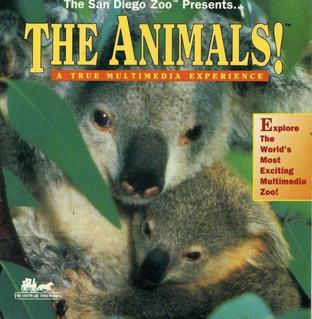Related Research Articles

The Compact Disc-Interactive is a digital optical disc data storage format as well as a hardware platform, co-developed and marketed by Dutch company Philips and Japanese company Sony. It was created as an extension of CDDA and CD-ROM and specified in the Green Book specifications, co-developed by Philips and Sony, to combine audio, text and graphics. The two companies initially expected to impact the education/training, point of sale, and home entertainment industries, but the CD-i is largely remembered today for its video games.

The LaserActive is a converged device and fourth-generation home video game console capable of playing LaserDiscs, Compact Discs, console games, and LD-G karaoke discs. It was released by Pioneer Corporation in 1993. In addition to LaserActive games, separately sold add-on modules accept Mega Drive/Genesis and PC Engine/TurboGrafx-16 ROM cartridges and CD-ROMs.

Welcome to Pooh Corner is a live-action/puppet television series that aired on Disney Channel, featuring the characters from the Winnie the Pooh universe portrayed by actors in human-sized puppet suits, except Roo, who was originally a traditional puppet. The animatronic costumes used for the characters were created by Alchemy II, Inc., headed by Ken Forsse who later created Teddy Ruxpin. The show was first aired on April 18, 1983, the day The Disney Channel was launched. Its timeslot for its early run was at 8:30 a.m. Eastern/Pacific Time, making it the third program of The Disney Channel's 16 hour programming day. Reruns of the show aired on The Disney Channel until May 30, 1997.

Living Books is a series of interactive read-along adventures aimed at children aged 3–9. Created by Mark Schlichting, the series was mostly developed by Living Books for CD-ROM and published by Broderbund for Mac OS and Microsoft Windows. Two decades after the original release, the series was re-released by Wanderful Interactive Storybooks for iOS and Android.
Muppet Kids is a sub-franchise of The Muppets created by Jim Henson, that ran throughout the 1989 to the 2000s. Like Muppet Babies, the series featured child/pre-teen versions of the Muppets consisting of: Kermit, Miss Piggy, Animal, Gonzo, Fozzie, Bean Bunny, Rolf, Janice, Skeeter and Scooter.
An authoring system is a program that has pre-programmed elements for the development of interactive multimedia software titles. Authoring systems can be defined as software that allows its user to create multimedia applications for manipulating multimedia objects.

Arthur's Teacher Trouble is a book in the Arthur series, released in 1986. It was written by Marc Brown and published by Little, Brown and Company and The Living Books Company.
Mark Schlichting is a publisher, author, and digital pioneer of children's multimedia and interactive design software. He is best known as the creator and subsequent Design and Art Director of Broderbund's Living Books series including the original 1994 Living Books PC game Harry and the Haunted House, one of the first lines of children's interactive book software on CD-ROM. Schlichting was Design and Art Director for Living Book's first interactive CD-ROM book adaptation, Mercer Mayer’s Just Grandma and Me, which was one of the first software titles accredited as a school textbook and used as a product demonstration by Apple CEO John Sculley.
There have been a variety of Sesame Street video games released for video game platforms. Most of the Sesame Street video games were published and developed by NewKidCo.

Giggle and Hoot is an Australian children's television "wrap-around" program block that aired on the ABC Kids channel. The series was produced from 2009 to 2019, with the final episodes airing in 2020, and depicted the adventures of Jimmy Giggle and his best friend, Hoot the Owl. It also aired on ABC from 2009 to 2011. In later seasons, they were joined by a second owl called Hootabelle along with other friends and their toys.

Mattel Interactive was a video game publisher and software distributor.
The Magic School Bus is a series of educational video games developed by Music Pen and published by Microsoft via their Microsoft Home brand. The interactive adventures are part of the larger franchise and based with The Magic School Bus original series books and public television series.

The American Girls Premiere is an educational computer game developed and published by The Learning Company for American Girl. The game allows players to create theatrical productions featuring characters from American Girl's Historical collection, along with scenes and other elements unique to each of the girls' respective time periods.
LV-ROM is an optical disc format developed by Philips Electronics to integrate analog video and computer software for interactive multimedia. The LV-ROM is a specialized variation of the CAV Laserdisc. LV-ROM is an initialism for "LaserVision Read-Only Memory".

Disney's Animated Storybook is a point-and-click adventure interactive storybook video game series based on Walt Disney feature animations and Pixar films that were released throughout the 1990s. They were published by Disney Interactive for personal computers for children ages four to eight years old. Starting from 1994, most of the entries in the series were developed by Media Station. They have the same plots as their respective films, though abridged due to the limited medium.
Madeline is a series of educational point-and-click adventure video games which were developed during the mid-1990s for Windows and Mac systems. The games are an extension of the Madeline series of children's books by Ludwig Bemelmans, which describe the adventures of a young French girl. The video-game series was produced concurrently with a TV series of the same name, with characters and voice actors from the show.

Monopoly Star Wars is the 1997 Monopoly Star Wars video game based on the board game and set in the Star Wars fictional universe. It is one of many Monopoly video game adaptions. The game was developed by Artech Studios and published by Hasbro Interactive. It was released exclusively for Microsoft Windows computers. The game employs the same basic ruleset of traditional Monopoly gameplay, but the Star Wars theme includes famous characters and locales in place of the original game pieces and properties.

The San Diego Zoo Presents: The Animals is an educational game developed by the Software Toolworks and Arnowitz Studios and published by The Software Toolworks in 1992 for Windows. Arnowitz Studios developed the multimedia assets and The Software Toolworks did the software development. A release for 3DO was planned for release in November 1993 but was ultimately launched in 1994. The game was then ported to Sega CD in 1994.

3-D Dinosaur Adventure is an educational video game by Knowledge Adventure released on CD-ROM for MS-DOS compatible operating systems in 1993. Versions for Macintosh and Windows 3.x were published in 1996. A 1997 re-release and an updated version for Macintosh and Microsoft Windows is titled 3-D Dinosaur Adventure: Anniversary Edition.
Puppet Motel is a 1995 CD-ROM developed by The Voyager Company and released exclusively for the Apple Macintosh. Written and featuring by American singer-performance artist Laurie Anderson and designed by Hsin-Chien Huang, the CD-ROM is a mixture of video, audio and interactive digital artwork. The title comes from a song on Anderson's then-recent album, 1994's Bright Red. The song is among numerous Anderson compositions performed on the soundtrack, which features the first release of the song "Down in Soho". Anderson appears in digitized video form, both as herself and, as the voice of a ventriloquist's dummy. The CD-ROM contains many Easter eggs: hotspots that trigger video or audio segments. For example, clicking in the correct spot will trigger a video of the dummy performing the song "Puppet Motel".
References
- ↑ "A-to-Z software index: A retailer's guide to the garden world of children's entertainment". Billboard. Vol. 98, no. 30. Nielsen Business Media, Inc. 26 July 1986. pp. K3, K8. Retrieved 2017-09-13.
- ↑ "Mr. Know It Owl's Video School". Archived from the original on 2021-12-19.
- ↑ "Discovery Acquires AIMS Multimedia". Archived from the original on 2014-09-09.
- ↑ "Discovery Acquires AIMS".